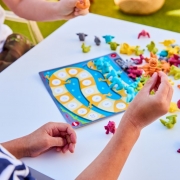Toy Safety Directive
How to shop safely online
All products manufactured for babies and children from cribs to clothing to toys have to meet certain safety standards. While both the standards and the requirements for warning labels are governed by country-specific laws and regulations, there are common factors across the world.
These days increasing numbers of toys and child products are bought online, either directly from the manufacturer or main distributor, or via third-party sellers. Given that anyone can set up a store via marketplace platforms such as Amazon, E-bay or even Facebook and reach millions of potential customers, how can safety standards be enforced? And what can individual buyers do to protect the children they love?
In part 1 of this topic we talked about safety tips to follow when choosing toys for your child, or as a gift for someone else.
Now we are going to focus more on what companies are doing on your behalf.
Amazon is the largest single marketplace in the world, so the influence it wields is enormous. In terms of toy safety, how well is it doing? E-bay is a baby compared to Amazon, but is growing year on year and has the added complication that many sellers are individuals selling second-hand products no longer required by their own family.
News reports on unsafe toys
In the last few months, there have once more been reports in newspapers and online media about unsafe toys. Many of these reports on work carried out by the British Toy and Hobby Association (BTHA) and Which? who both regularly test different products. Concerns have been raised about a number of products easily available on sites such as Amazon, eBay or AliExpress.
The dangers posed by these products include the use of toxic chemicals in products such as slime or putty, choking hazards from small parts, and batteries or magnets that are too easily accessible by a young child who may swallow them, mistaking them for sweets.
No one wants to be responsible for toy-related injuries, yet emergency departments see too many cases.
Amazon response
Amazon layout very clear rules for their sellers. In their documents for marketplace traders (in Europe, where the Toy Safety Directive – TSD – applies) they state:
Therefore, if you sell or intend to sell toys on the Amazon marketplace, you must:
- Familiarise yourself with all requirements under the TSD and the relevant national implementing laws.
- Ensure that each of your products and all accompanying product information are fully compliant with those requirements.
There is much more detailed guidance which follows this headline statement. Specific guidance applies to different categories of toys, for example for younger or older children, indoor or outdoor toys. It is clear that Amazon wishes to take toy safety seriously, but with over six million marketplace sellers worldwide it is hard to see exactly how they can enforce it.
Earlier this year they introduced enhanced controls that proactively require sellers to provide safety documentation for the toys they are applying to sell on Amazon. But ultimately, it is in everyone’s best interests for the buyers to be as informed as possible.
What to be aware of
Any product that is manufactured or distributed in the United States will have been designed and manufactured to comply with legislation from the Consumer Product Safety Commission (CPSC). In the UK they must comply with the Toys (Safety) Regulations, and in the EU with the Toy Safety Directive. Other countries will have similar legislation.
Reputable manufacturers will have their products tested by an independent testing company to ensure they reach the minimum standards in the country of manufacture and any other country where they expect to sell the product. For example, in the USA testing would have to be carried out to show compliance to standards such as ASTM F963-17 and CPSIA. This requirement applies to both manufacturers and importers. Tests cover all aspects of safety with separate standards, for example, for stuffed toys, plastic toys, wooden toys or any other type of material. Art materials, including paints and crayons, must be free from toxic ingredients, as well as warnings about any possible choking hazard.
Making good choices
When looking at the photo and description of the product, therefore, check that the manufacturer name and address is clearly identified and that this is a reputable company. Many of the big names in the industry are immediately recognisable. Just because a manufacturer is newer and/or smaller does not mean their products are of dubious quality, but take a moment to do your homework.
Make sure that the product pictured is the same as the one that was tested. Be cautious, avoid toys that do not clearly comply with the safety standards of your country, and then relax allowing your child to play safely and develop their knowledge and skills with the right kinds of toys.

 Edx Education
Edx Education
